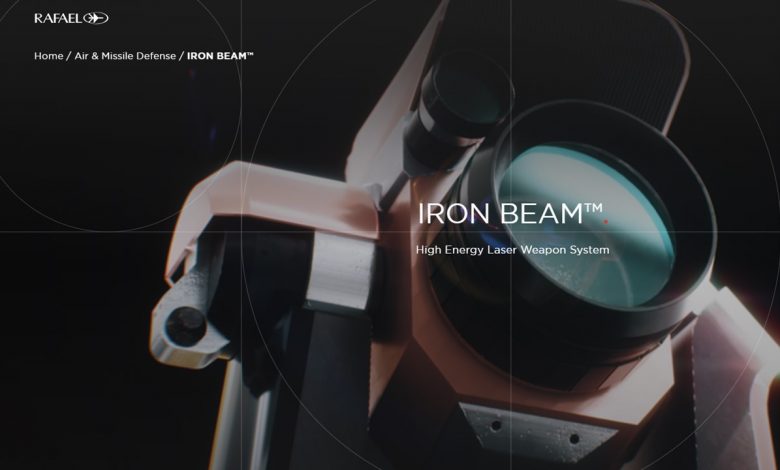From Sci-Fi to Reality: Laser Weapons Now a Battlefield Reality

“We have also completed trials on two more types of laser weapons۔”
Yoav Tourgeman, Head of Rafael Advanced Defense Systems
With laser weapons, the 21st century is the fastest-moving century in human history—so fast that it has even changed our perception of lethality. Today, sitting in a control room thousands of miles away, destroying a house or killing a person using a drone is no longer surprising. Integrating various weapons, defense systems, and surveillance satellites using artificial intelligence has also become routine. Even shooting down an unidentified enemy aircraft hundreds of kilometers inside enemy territory from within one’s own borders is no longer “news.”
Gradually, war is shifting from traditional battlefields to remote control rooms. Now, instead of soldiers with guns, it is sharp-eyed technicians sitting in air-conditioned rooms, operating joystick consoles, who are calling the shots—literally. Every few months, a new scientific or military breakthrough replaces the last headline-grabbing advancement, a renowned Pakistani journalist, Wusatullah Khan stated in his recent article.
You may recall that in 1983, U.S. President Ronald Reagan announced the Strategic Defense Initiative, commonly known as the Star Wars program, which aimed to build a missile defense shield over the United States against Soviet nuclear threats. One component of that plan involved using laser weapons. At the time, it sounded like science fiction, and due to technological limitations, the project was later shelved. However, by then, over $250 billion had already been spent, and the vision was locked away in research labs۔
Still, as some say, experiments may seem to fail, but they never truly fail. Although the Star Wars project did not create an integrated missile shield, it led to critical developments such as the Patriot missile system, the THAAD system, and the Iron Dome, jointly developed by the United States and Israel. More recently, President Donald Trump proposed the Golden Dome project, aiming for completion by 2030 to further secure the U.S. homeland.
Meanwhile, Russia developed its own missile defense systems—the S-300, S-400, and S-500—and China is rapidly advancing in the same domain.
While laser weapons have been portrayed in films since the 1960s, the concept has now transitioned from reel to real. A laser moves at the speed of light, making it the ultimate defensive weapon in theory: capable of striking incoming threats before they reach their targets.
In May 2025, Israel revealed that it had not only developed laser weapons but had also successfully used them in trials to counter Hezbollah drone attacks in northern Israel since October 2023. Reportedly, these lasers helped shoot down approximately 40 drones. The trials were completed in 2023.
The laser gun has been developed by Rafael Advanced Defense Systems, a key contractor for the Israeli Ministry of Defense and the same company that helped develop the Iron Dome. Rafael claims it has successfully tested a 10-kilowatt laser on the battlefield in northern Israel.
If these reports are accurate, Israel has become the first country to use laser weapons in active combat. However, Israel is not the first to experiment with lasers. Countries like the U.S., Russia, the U.K., Germany, China, and Japan are all developing similar technologies. In January 2024, the U.K. used its DragonFire laser to shoot down an airborne test target, though it doesn’t expect deployment before 2027.
The U.S. Navy also tested a 60-kilowatt high-energy laser developed by Raytheon last year. The U.S. is also working on more powerful versions, like HEL-CAP and HELSI, each expected to generate over 300 kW. However, their induction into active service remains uncertain. Meanwhile, China may surprise the world by leapfrogging into leadership in this field.
“We’ve also completed tests on two more types of laser weapons,” said Yoav Tourgeman, Head of Rafael. “One laser is 250 mm wide with 50 kW of energy, named Iron Beam, while the advanced version, Iron Beam-M, is 450 mm wide and delivers 100 kW, capable of neutralizing heavy missiles.”
Tourgeman confirmed that the Israeli Defense Forces (IDF) will receive the first batch of these laser weapons later this year.
These laser systems will supplement the Iron Dome by engaging any targets that slip through. The Iron Beam can strike aerial threats at altitudes of up to 10 kilometers. However, weather remains a challenge—clouds and pollution can reduce its effectiveness. It performs best in clear skies and is thus most suitable for low-altitude threats for now.
Israel recently showcased its laser systems at a defense exhibition in Paris.
So far, no weapon has been invented without a countermeasure. As laser technology becomes widespread, adversaries will certainly develop tactics or tools to counter it. That’s the unfortunate nature of warfare—every breakthrough invites another.




